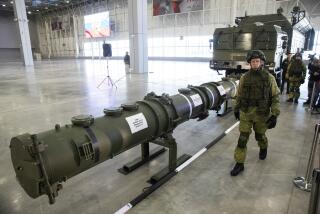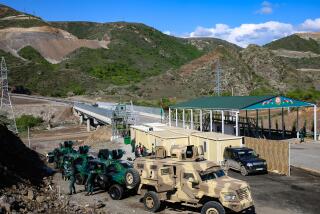Next Step : START Treaty Leaves Both Sides Thinking, What Now? : * The accord still leaves plenty of nuclear arms in each arsenal. The focus may turn to broader security issues.
- Share via
MOSCOW — “We may be arriving at the end of an era of easy arms control,” a Bush Administration official mused last week, contemplating the completion of the Strategic Arms Reduction Treaty. “The kind of arms control we’ll be looking at from now on is going to seem hard by comparison.”
Negotiating START wasn’t easy, of course--the 750-page agreement took nine years, two U.S. Presidents and four Soviet leaders to achieve. But the massive treaty does define an entire era in arms control, and its completion leaves negotiators in both Washington and Moscow uncertain where to go next.
When President Bush and Soviet President Mikhail S. Gorbachev sign the START pact at the Kremlin on Wednesday, it will be a historic step, the first time the two superpowers have actually agreed to cut their long-range nuclear arsenals.
But despite its achievement in reducing by roughly 30% the fast-flying intercontinental missiles that are the most dangerous nuclear weapons, START will still leave the United States and the Soviet Union with a combined total of about 18,000 nuclear warheads--enough to destroy each other in a matter of minutes.
At the same time, the threats posed by high-technology weaponry around the world are proliferating rapidly, from nuclear weapons programs in Iraq and other would-be superpowers to burgeoning chemical weapons and non-nuclear ballistic missiles.
In that daunting environment, it may seem paradoxical that some Administration officials have been talking about a “pause” in nuclear arms control before launching any new reduction efforts. “It has been an exhausting process,” Defense Secretary Dick Cheney explained to the Senate Foreign Relations Committee on July 16, “and there may well be people in the process who are not eager to go out and start over again.”
In fact, the fundamental conditions surrounding the U.S.-Soviet arms control effort have changed so completely--now that a Soviet military threat to the United States seems almost inconceivable--that experts in both Washington and Moscow say START may well be the last of its breed.
“Arms control as a whole will continue to be important, but it won’t be as important as it used to be--if only because a lot of other things have become more important,” said Raymond Garthoff, a former U.S. arms negotiator now at the Brookings Institution. “It is quite possible that START will end up being the last major strategic arms agreement of this kind. There may be smaller efforts in one area or another, but the enthusiasm for big, comprehensive treaties like START has waned. There’s a feeling that smaller, more limited efforts could mean more progress sooner.”
“The old approach to arms control is basically exhausted,” agreed Sergei Karaganov, a leading Soviet arms control expert, because “the threat we were working to reduce . . . has been reduced politically.”
Soviet leaders who once pressed for deep cuts in nuclear weaponry have lost some of their enthusiasm for another reason, Karaganov added. “Nuclear weapons, sadly but truly, are the only thing that gives us superpower status,” he said in an interview in Moscow. “With all the (political) crises that we are going to face in the next 15 years, it is not really common sense to create another one by trying to strip (nuclear arsenals) down to the bare minimum.”
In Washington and Moscow, superpower strategists are asking three fundamental questions about the future of arms control:
* Can the superpowers build on the START agreement to cut their arsenals further?
* Are there other approaches to arms control that would help stabilize the nuclear balance more effectively?
* How much time will either government want to invest in nuclear negotiations in view of the growth of other military dangers--and the incipient disintegration of the Soviet Union?
Bush and Gorbachev plan to take up those issues at this week’s summit meeting.
“There will be some talks about the future of arms control,” Brent Scowcroft, Bush’s national security adviser, told reporters last week. “How can we change the focus of arms control, which up to now has been a competitive process dealing with issues on which the two sides are antagonistic, into what ought to be a broader security relationship?”
One way, in the view of some mostly liberal arms control experts, would be to take the START ceilings on missiles, bombers and nuclear warheads and simply cut them further.
“You could cut those limits in half by a very simple addendum to the START treaty, and you wouldn’t have to revise any part of our strategic doctrine,” suggested Paul Warnke, former President Jimmy Carter’s chief arms negotiator.
Administration officials balk at that approach. “ ‘Cuts for the sake of cuts’ is not good arms control,” said a senior official who participated in the START talks. Asked if the Administration would take a “deep cuts” offer to Moscow, he replied: “The U.S. government has no proposal.”
Instead, he said, the Administration wants the next phase of talks to “concentrate on reducing ballistic missile warheads (and) eliminating heavy ICBMs,” the Soviet weapons that have long been the center of U.S. concerns.
The quickest way to do that, experts both inside and outside the Administration have been arguing, is to seek more limited arms agreements that would be “add-ons” to START.
“Many believe that what we should go for is not a single new START II agreement, but make adjustments in a bite-sized or incremental fashion,” said Edward L. Warner III of the Santa Monica-based RAND Corp. “That takes as a given that you use the START framework, including its verification provisions, and you adjust this ceiling or that ceiling. . . . I think that is a very promising route.”
A potential problem with this approach, Garthoff warned, is that the Soviets would be likely to respond to a U.S. proposal for cuts in their heavy missiles with a corresponding proposal for restricting the submarine-borne missiles that are the United States’ main strategic advantage--an issue American strategists have sought to avoid.
Last week, the chief of staff of the Soviet navy, Adm. Konstantin Makarov, charged that the “massive deployment” of U.S. sea-based nuclear weapons had already canceled out the reductions achieved in START.
Still, Garthoff said, “We ought to present our ideas and see what the Soviets come back with.”
Stanislav Kondrashov, a foreign-policy columnist at Izvestia, the Soviet government newspaper, noted that the Soviet military increasingly views its nuclear arsenal as “the only remaining material proof of our Great Power status. . . . What that means is that we may drive much harder bargains in arms control if we continue right on from START. And that in turn would mean slow progress and disappointment.”
The good news, on the other hand, is that because of economic distress in both countries, the United States and the Soviet Union will each be under pressure to reduce the size of their military budgets.
“Both sides have decided that they want to go down,” Warner noted. “But they want to go down simultaneously. They need guidelines to make sure the process of going down is stabilizing, not destabilizing.”
A second new approach that some experts have proposed is called “operational arms control”--restricting what countries do with their nuclear weapons, not just how many they have.
“There could be agreements of a different nature, deployment constraints or controls on operational practices rather than the number of units,” Garthoff said. But he acknowledged that work in this area is “pretty preliminary stuff.”
Still, an obvious focus for arms control over the next few years is “risk reduction”--making sure nuclear weapons aren’t launched accidentally and, in the case of the disintegrating Soviet Union, that they don’t fall into the wrong hands. “We’ve been working hard with the Soviets in that area, and we’re going to work harder,” one official said.
There is one major complicating factor on the nuclear horizon: the Strategic Defense Initiative, the U.S. program to devise weapons that could shoot down nuclear missiles before they arrive. Bush has scaled back the Ronald Reagan Administration’s plan for a global nuclear shield to a less-ambitious project called “GPALS” (pronounced “Gee, pals,” and meaning Global Protection Against Limited Strikes) to defend against accidental or rogue launchings of single missiles, and he plans to outline the idea to Gorbachev in Moscow.
“I think it will be received much more favorably than was President Reagan’s 1983 announcement (of SDI),” Scowcroft said dryly. The 1983 announcement provoked a Soviet walkout from the START talks; the issue wasn’t solved until 1989, when the Soviets agreed to move ahead with START while reserving the right to withdraw from the treaty if the United States went ahead with SDI.
The issue could still create major problems. “If the Administration has its way on SDI, there’s a good chance that START will never be fully implemented (by the Soviets),” said Spurgeon M. Keeny Jr., president of the private, Washington-based Arms Control Assn. “And it’s extremely unlikely that we’d ever see a START II in the foreseeable future.”
Meanwhile, other kinds of arms control are increasingly competing for center stage. Bush has made the construction of global regimes restricting chemical and biological weapons and non-nuclear ballistic missiles a major goal of his presidency. Cheney and other officials have suggested that those--not more nuclear arms reductions--are likely to come first on Bush’s agenda. And aides to Secretary of State James A. Baker III have said privately that they doubt the Administration has the time--or the energy--to pursue both kinds of arms control at once.
Progress in non-nuclear arms control may take as much time as START did, however. Bush’s proposals for global controls on chemical and biological weaponry have received widespread support, but making them binding and enforceable will take more time. The 16-nation Missile Technology Control Regime has taken some first steps toward restricting the proliferation of ballistic missiles, “but it’s almost invisible, and nobody pays attention except a few aficionados,” an Administration official complained.
Even Bush’s call for restraint by the great powers on their arms exports to the Middle East, announced with fanfare at the end of the Gulf War, has met tough sledding. Earlier this month, the Middle East’s main arms suppliers--the United States, the Soviet Union, France, Britain and China--met in Paris to discuss ways to cut the flow of jet fighters, attack helicopters and other advanced weapons to the area. But the meeting produced little more than a joint appeal for “restraint” and an agreement to meet again. The Administration, after announcing $13 billion in planned arms sales to Saudi Arabia, Israel and other Middle Eastern allies, found no other country willing to be the first to give up lucrative arms exports.
“Nuclear arms control had one virtue: it was just two superpowers, with a growing record of experience in dealing with each other,” an Administration official noted. “These other kinds of arms control are all multilateral--five countries, 16 countries, in some cases potentially a hundred countries. And that makes them exponentially more complicated.”
Times staff writers John M. Broder in Washington and Michael Parks in Moscow also contributed to this report.
More to Read
Sign up for Essential California
The most important California stories and recommendations in your inbox every morning.
You may occasionally receive promotional content from the Los Angeles Times.











